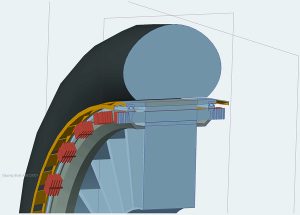Motor Integrated as the Front Wheel of an Electric Motorcycle
MS student Leslie Cheng with advisor K. Haran
This project involves sizing and packaging a motor designed to be integrated as the front wheel of an electric motorcycle, as shown in Figure 3.
Benefits include enabling all-wheel drive and independent wheel control. The outer-rotor design, sized to minimize weight, uses a Halbach array for the magnets and high pole count to thin out the rotor. Concentrated windings were also used to make it as flat as possible. The resulting machine, as shown in a cross section (Figure 4), has a very thin stator. Simulations verified a low flux density between teeth.
The motor, rated for 32 kW continuous at 2300 RPM, is cooled by fully sealing the machine and using heat pipes to extract heat directly from the windings. A small fan is integrated along the rotor for air flow across the heat sinks attached to the pipes. A large heat sink is attached to the inner stator diameter. The active region is only an inch thick with an outer diameter of 17 inches. With funding from the Grainger Center for Electric Machinery and Electromechanics, a small hardware test was performed with heat pipes showing a 40 ºC difference with and without heat pipes for a winding reaching 156 ºC.

